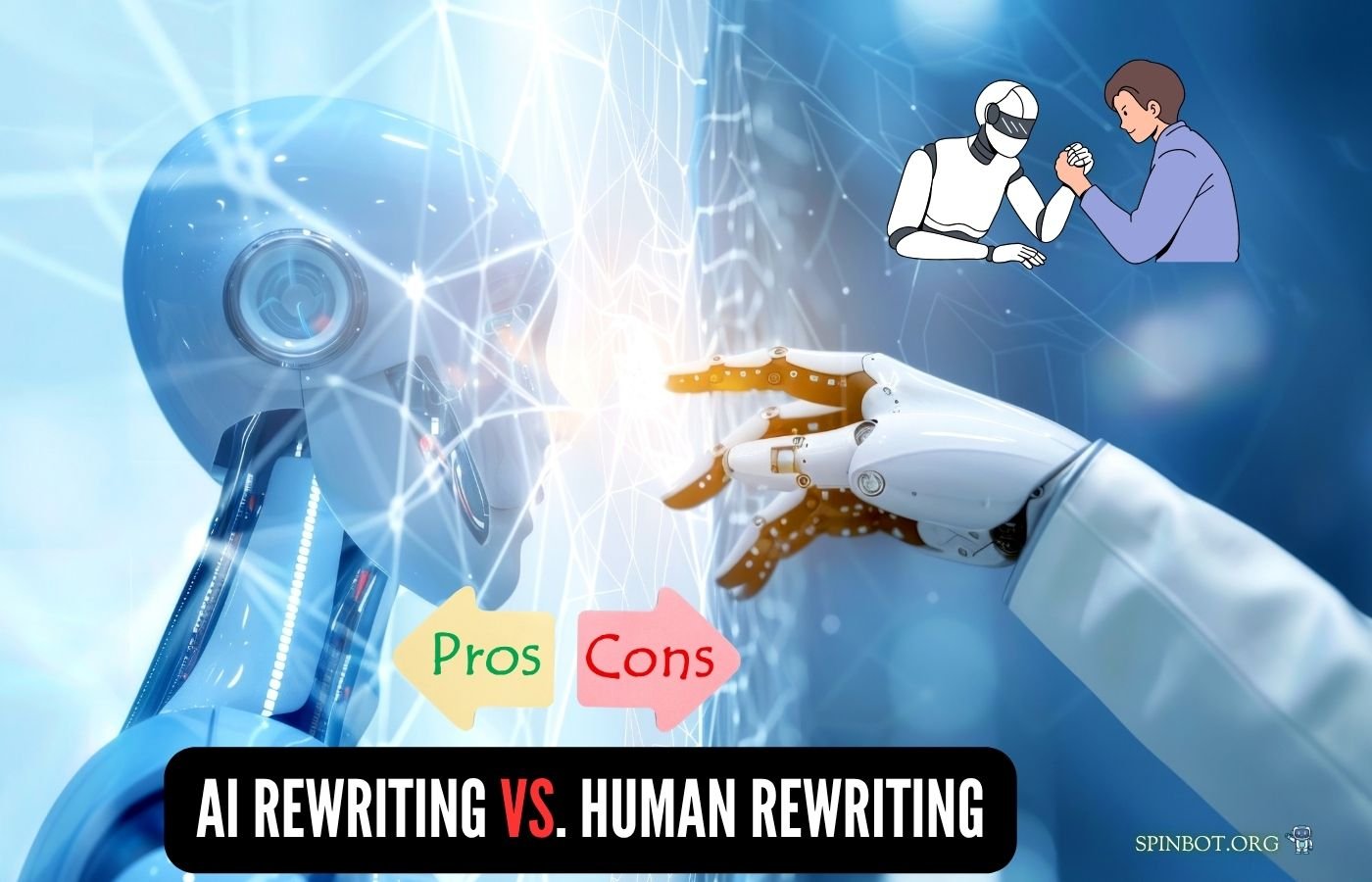In today’s fast-paced world, content rewriting has become a crucial part of digital marketing, SEO, and content creation. As artificial intelligence (AI) continues to evolve, many businesses and content creators are faced with a critical decision: should they rely on AI to rewrite their content, or is human rewriting the better option? In this article, we’ll explore the pros and cons of AI vs. human rewriting and discuss when each method shines.
What is Rewriting?
Before diving into the comparison, it’s essential to understand what rewriting entails. Rewriting involves taking an existing piece of content and rephrasing or restructuring it while retaining the core message. This can be done to improve clarity, eliminate plagiarism, optimize for SEO, or tailor the content to a different audience. Whether done by a human or an AI tool, rewriting is an indispensable part of content creation in many fields, including marketing, education, and journalism.
Understanding AI in Rewriting
AI rewriting tools are powered by advanced machine learning algorithms, specifically natural language processing (NLP). These tools can automatically generate rewritten content by analyzing text, recognizing its meaning, and producing new versions of it. AI rewriting is particularly useful for content creators looking to automate repetitive tasks or produce large volumes of content quickly.
Some well-known AI tools used for rewriting include Spinbot, Quillbot, and Jasper AI. These tools use data to generate outputs that are similar to the original text but restructured in a way that’s unique.
Human Rewriting: A Traditional Approach
Human rewriting involves a writer reading the original content, understanding its message, and then crafting a new version with improved clarity, style, and tone. Unlike AI, human writers can inject creativity, context, and a personalized touch into the content. They also possess the ability to understand complex emotions, nuances, and subject matter, something that AI tools often struggle to do.
Human rewriting is ideal for industries that require a high level of creativity, such as advertising, literature, and public relations. It’s also the go-to choice when the goal is to produce content that engages readers on a deeper, emotional level.
Pros of AI Rewriting
AI has undoubtedly revolutionized content rewriting, offering a range of advantages for businesses and content creators. Let’s break down the pros of AI rewriting:
1. Speed and Efficiency
AI can rewrite large volumes of content in a fraction of the time it would take a human to do the same. This makes AI rewriting ideal for tasks like bulk content creation, SEO articles, or social media posts.
The ability to process and rewrite content quickly allows businesses to keep up with the high demand for content without sacrificing time or productivity.
2. Cost-Effective
AI rewriting tools are often more affordable than hiring professional writers, especially for tasks that require high-volume output. For businesses with tight budgets, AI tools offer a budget-friendly solution without compromising on content quality.
They eliminate the need for a large team of writers, making them a viable option for startups or small businesses.
3. Consistency
AI tools ensure that the rewritten content maintains a consistent tone, style, and structure. This is particularly useful when a brand needs uniformity across different pieces of content.
For large-scale campaigns, consistency in content is vital for maintaining brand identity and audience trust.
4. Multilingual Capabilities
Many AI tools are capable of handling content in multiple languages, allowing businesses to reach a broader, international audience.
AI rewriting tools can easily translate and rewrite content, helping businesses localize their content for different regions.
5. Language Proficiency
AI tools are trained on vast datasets, enabling them to produce grammatically correct and structurally sound content.
AI rewriting can handle a variety of language structures and even intricate sentence patterns, ensuring the rewritten content is polished and professional.
Cons of AI Rewriting
Despite the many benefits, AI rewriting has its limitations. Here are the cons of AI rewriting:
1. Lack of Creativity
AI tools can’t replicate the creativity that human writers bring to the table. While they can generate content, they often lack the depth and originality that a human writer can provide.
For creative content, such as storytelling or personal blogs, AI rewriting might fall short, as it cannot think outside the box.
2. Context Understanding
AI tools can struggle to understand complex contexts or deep subject matter. They may not be able to grasp the subtle nuances of a topic, which could result in content that feels flat or incomplete.
Human writers, on the other hand, have the ability to contextualize information, which is essential for topics that require a nuanced understanding.
3. Potential for Errors
Even the most advanced AI tools make mistakes, especially when dealing with idiomatic expressions, cultural references, or language-specific nuances.
While AI tools can generate grammatically correct content, they may miss the mark when it comes to accuracy or appropriateness in certain contexts.
4. Ethical Concerns
One significant concern is plagiarism. While AI tools are designed to avoid direct copying, they can still produce content that is too similar to the original text. This can lead to issues with plagiarism detection and copyright violations.
Many content platforms and search engines, like Google, penalize duplicate or non-original content, which could hurt SEO rankings.
5. Lack of Emotional Connection
AI cannot establish an emotional connection with readers. Content that relies on empathy, humor, or personal experience is best written by humans, who understand how to engage and connect with an audience.
Pros of Human Rewriting
Human rewriting is still the gold standard in many industries. Here are some reasons why human rewriting is invaluable:
1. Creativity and Inn ovation
Human writers can think creatively, producing content that is not only informative but also engaging and unique. They can inject personality, humor, and emotional depth into the content, which makes it stand out.
Creative industries, such as advertising and storytelling, often require a level of innovation that AI simply cannot replicate.
2. Contextual Understanding
Human writers are adept at understanding the deeper context of content. They can research and analyze topics thoroughly, ensuring that the rewritten text is both accurate and relevant.
For highly technical or specialized content, humans are better equipped to grasp complex concepts and convey them effectively.
3. Quality and Engagement
Human writers focus on quality, ensuring that the content is not only rewritten but also enhanced. They can refine sentences, improve structure, and adjust tone to make the content more engaging for readers.
SEO copywriting, blogging, and creative writing benefit from human insights, as they can tailor content to the audience’s preferences.
4. Emotional Connection
One of the biggest strengths of human writers is their ability to connect with readers on an emotional level. Whether it’s storytelling, persuasive writing, or personal anecdotes, human writers can craft content that resonates with emotions and builds relationships.
This is particularly valuable in marketing, social media, and customer communication, where trust and engagement are essential.
Cons of Human Rewriting
Despite their expertise, human writers come with certain challenges:
1. Time-Consuming
Human rewriting is significantly slower than AI. A single piece of content might take hours or even days to rewrite, especially for more complex topics.
This makes human rewriting less efficient for tasks that require quick turnaround times or high-volume content production.
2. Higher Costs
Hiring skilled human writers can be expensive. For businesses or individuals with limited budgets, this can be a significant constraint.
The cost of professional writers adds up, especially for large-scale content projects.
3. Inconsistency
While human writers bring creativity, they may not always be consistent in their tone, style, or writing approach.
For businesses that require uniformity in their content, relying on multiple writers can lead to discrepancies and a lack of cohesion across content.
4. Limited Scalability
Scaling content production is challenging with human writers. There’s a limit to how much a single writer or even a team of writers can produce in a given time frame.
This can be a problem for businesses needing content at scale.
AI vs. Human Rewriting: A Comparison
| Feature | AI Rewriting | Human Rewriting |
|---|---|---|
| Speed | Fast, can handle large volumes of content | Slow, especially for complex content |
| Cost | Affordable, cost-effective for bulk content | Expensive, especially for high-quality work |
| Creativity | Lacks creativity, limited by programming | Highly creative, can add unique touches |
| Consistency | Highly consistent | May vary depending on the writer |
| Contextual Understanding | Limited, struggles with complex topics | Deep understanding, can handle nuances |
| Emotional Connection | Cannot establish emotional ties | Can engage readers emotionally |
When to Choose AI Over Human Rewriting
AI rewriting is ideal in the following situations:
High-volume content: If you need a large amount of content quickly, AI is the clear winner.
SEO content: AI is great for producing keyword-rich content that ranks well on search engines.
Budget constraints: For businesses that cannot afford professional writers, AI rewriting tools offer an affordable alternative.
Routine tasks: Tasks that don’t require deep creativity or emotional engagement are perfect for AI tools.
When to Choose Human Rewriting Over AI
Human rewriting is better when:
Creative and emotional content is required: For content that aims to engage readers emotionally or requires a unique touch, human writers excel.
In-depth subject matter: When the content is technical, specialized, or requires expert knowledge, human writers are the better choice.
High-quality, original content: Human writers ensure that the content is both high-quality and original, avoiding any potential plagiarism.
The Future of AI and Human Rewriting
AI is undoubtedly advancing, but it is unlikely to completely replace human writers anytime soon. Instead, AI and human rewriting can complement each other. AI can assist human writers by handling mundane tasks, while humans can provide the creativity and nuanced understanding that AI lacks. The future of rewriting lies in collaboration, with AI as an assistant rather than a replacement.
Conclusion
The debate between AI and human rewriting is not a simple one. Both have their strengths and weaknesses, and the best choice depends on your specific needs. For high-quality, engaging, and emotionally resonant content, human rewriting remains the gold standard. However, for speed, efficiency, and cost-effectiveness, AI rewriting tools provide a valuable solution. By understanding the pros and cons of AI vs. human rewriting, you can make an informed decision that aligns with your goals and resources.

AI writing strategist with hands-on NLP experience, Liam simplifies complex topics into bite-sized brilliance. Trusted by thousands for actionable, future-forward content you can rely on.

